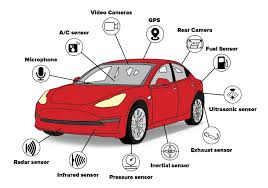The Automotive Sensors Market: Driving Innovation in Modern Vehicles
The automotive
industry is experiencing a technological revolution, and at the heart of
this transformation lies the rapidly expanding automotive sensors market. These
sophisticated devices have become the nervous system of modern vehicles,
enabling everything from basic safety features to advanced autonomous driving
capabilities. As we navigate through 2025, the automotive sensors market
continues to demonstrate remarkable growth, driven by evolving consumer
expectations and stringent safety regulations.
To Explore More Details- https://futuremarketanalytics.com/report/automotive-sensors-market/
Market Dynamics and Growth Trajectory
The global automotive sensors market has witnessed
unprecedented expansion, with industry analysts projecting substantial growth
through the remainder of the decade. This surge is primarily attributed to the
increasing integration of electronic systems in vehicles and the automotive
industry's shift toward electrification and automation. The market encompasses
various sensor types, including pressure sensors, temperature sensors, position
sensors, speed sensors, and image sensors, each playing a crucial role in
vehicle functionality.
Electric vehicles (EVs) have emerged as a significant
catalyst for market growth. These vehicles require sophisticated battery
management systems, thermal monitoring, and energy efficiency optimization, all
of which depend heavily on sensor technology. As governments worldwide
implement stricter emission regulations and provide incentives for EV adoption,
the demand for automotive sensors continues to escalate.
Key Sensor Technologies Shaping the Industry
Modern vehicles incorporate dozens of sensors, each serving
specific functions that enhance safety, performance, and user experience. LiDAR
sensors have gained prominence in autonomous vehicle development, providing
precise 3D mapping capabilities essential for navigation and obstacle
detection. Camera sensors work in conjunction with image processing algorithms
to enable features like lane departure warnings, pedestrian detection, and
traffic sign recognition.
Radar sensors have become indispensable for adaptive cruise
control and collision avoidance systems. Their ability to function effectively
in various weather conditions makes them particularly valuable for
safety-critical applications. Meanwhile, ultrasonic sensors facilitate parking
assistance and low-speed maneuvering, while inertial measurement units (IMUs)
contribute to vehicle stability control and rollover prevention.
Advanced Driver Assistance Systems (ADAS) Integration
The proliferation of ADAS technologies has created
substantial opportunities for sensor manufacturers. These systems rely on
multiple sensor inputs to create a comprehensive understanding of the vehicle's
environment. Features such as automatic emergency braking, blind spot
monitoring, and lane keeping assistance have transitioned from luxury options
to standard equipment in many vehicle segments.
The sensor fusion approach, where multiple sensor types work
together to provide redundant and complementary data, has become the industry
standard for ADAS implementation. This strategy enhances system reliability and
accuracy while providing fail-safe mechanisms crucial for safety-critical
applications.
Challenges and Market Constraints
Despite the promising growth prospects, the automotive
sensors market faces several challenges. Supply chain disruptions, particularly
in semiconductor manufacturing, have impacted sensor availability and pricing.
The complexity of integrating multiple sensor systems while maintaining
cost-effectiveness poses ongoing challenges for automotive manufacturers.
Standardization across different vehicle platforms and
manufacturers remains a significant hurdle. The lack of universal standards can
complicate sensor development and increase costs for suppliers serving multiple
automotive brands.
Future Outlook and Emerging Trends
The automotive sensors market is poised for continued
expansion as vehicles become increasingly connected and autonomous. Edge
computing integration within sensor systems promises to reduce latency and
improve real-time decision-making capabilities. Artificial intelligence and
machine learning algorithms are being embedded directly into sensor hardware,
enabling more sophisticated data processing at the source.
The emergence of Vehicle-to-Everything (V2X) communication
technology will require new sensor capabilities to facilitate seamless
interaction between vehicles, infrastructure, and other road users. This
connectivity revolution will likely drive demand for specialized communication
and environmental sensing technologies.
As the automotive industry continues its digital
transformation, sensors will remain at the forefront of innovation, enabling
safer, more efficient, and more intelligent vehicles that meet the evolving
needs of consumers and regulatory requirements worldwide.




Comments
Post a Comment